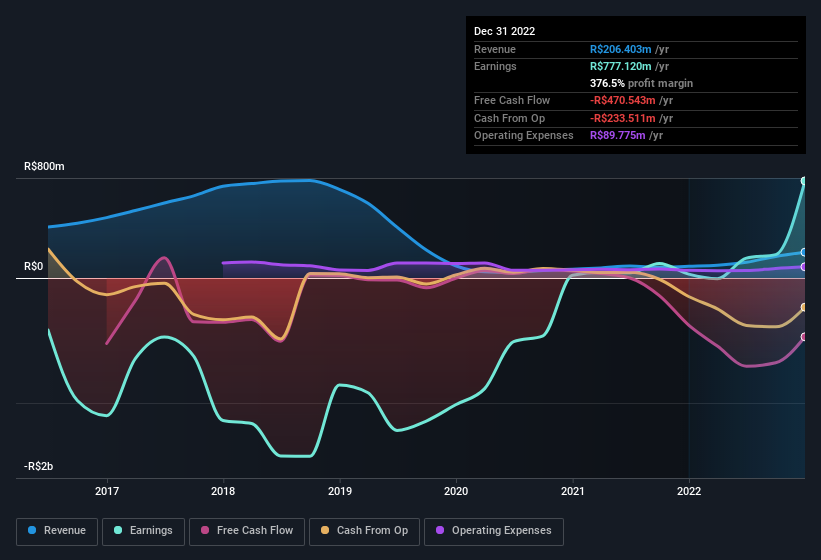- Brazil
- /
- Renewable Energy
- /
- BOVESPA:RNEW11
Renova Energia's (BVMF:RNEW11) Robust Earnings Are Not All Good News For Shareholders

Renova Energia S.A.'s (BVMF:RNEW11) stock rose after it released a robust earnings report. However, we think that shareholders should be aware of some other factors beyond the profit numbers.
Check out our latest analysis for Renova Energia

Examining Cashflow Against Renova Energia's Earnings
As finance nerds would already know, the accrual ratio from cashflow is a key measure for assessing how well a company's free cash flow (FCF) matches its profit. In plain english, this ratio subtracts FCF from net profit, and divides that number by the company's average operating assets over that period. You could think of the accrual ratio from cashflow as the 'non-FCF profit ratio'.
As a result, a negative accrual ratio is a positive for the company, and a positive accrual ratio is a negative. While having an accrual ratio above zero is of little concern, we do think it's worth noting when a company has a relatively high accrual ratio. Notably, there is some academic evidence that suggests that a high accrual ratio is a bad sign for near-term profits, generally speaking.
Renova Energia has an accrual ratio of 1.23 for the year to December 2022. As a general rule, that bodes poorly for future profitability. To wit, the company did not generate one whit of free cashflow in that time. In the last twelve months it actually had negative free cash flow, with an outflow of R$471m despite its profit of R$777.1m, mentioned above. Coming off the back of negative free cash flow last year, we imagine some shareholders might wonder if its cash burn of R$471m, this year, indicates high risk. However, that's not the end of the story. We must also consider the impact of unusual items on statutory profit (and thus the accrual ratio), as well as note the ramifications of the company issuing new shares.
Note: we always recommend investors check balance sheet strength. Click here to be taken to our balance sheet analysis of Renova Energia.
To understand the value of a company's earnings growth, it is imperative to consider any dilution of shareholders' interests. In fact, Renova Energia increased the number of shares on issue by 123% over the last twelve months by issuing new shares. Therefore, each share now receives a smaller portion of profit. Per share metrics like EPS help us understand how much actual shareholders are benefitting from the company's profits, while the net income level gives us a better view of the company's absolute size. Check out Renova Energia's historical EPS growth by clicking on this link.
A Look At The Impact Of Renova Energia's Dilution On Its Earnings Per Share (EPS)
Renova Energia was losing money three years ago. On the bright side, in the last twelve months it grew profit by 2,432%. But earnings per share are actually down 4.9%, over that same period. This is a great example of why it's rather imprudent to rely only on net income as a growth measure. And so, you can see quite clearly that dilution is having a rather significant impact on shareholders.
If Renova Energia's EPS can grow over time then that drastically improves the chances of the share price moving in the same direction. However, if its profit increases while its earnings per share stay flat (or even fall) then shareholders might not see much benefit. For the ordinary retail shareholder, EPS is a great measure to check your hypothetical "share" of the company's profit.
How Do Unusual Items Influence Profit?
The fact that the company had unusual items boosting profit by R$1.1b, in the last year, probably goes some way to explain why its accrual ratio was so weak. While it's always nice to have higher profit, a large contribution from unusual items sometimes dampens our enthusiasm. When we crunched the numbers on thousands of publicly listed companies, we found that a boost from unusual items in a given year is often not repeated the next year. And, after all, that's exactly what the accounting terminology implies. Renova Energia had a rather significant contribution from unusual items relative to its profit to December 2022. All else being equal, this would likely have the effect of making the statutory profit a poor guide to underlying earnings power.
Our Take On Renova Energia's Profit Performance
In conclusion, Renova Energia's weak accrual ratio suggested its statutory earnings have been inflated by the unusual items. The dilution means the results are weaker when viewed from a per-share perspective. On reflection, the above-mentioned factors give us the strong impression that Renova Energia'sunderlying earnings power is not as good as it might seem, based on the statutory profit numbers. With this in mind, we wouldn't consider investing in a stock unless we had a thorough understanding of the risks. Be aware that Renova Energia is showing 5 warning signs in our investment analysis and 3 of those don't sit too well with us...
Our examination of Renova Energia has focussed on certain factors that can make its earnings look better than they are. And, on that basis, we are somewhat skeptical. But there are plenty of other ways to inform your opinion of a company. For example, many people consider a high return on equity as an indication of favorable business economics, while others like to 'follow the money' and search out stocks that insiders are buying. So you may wish to see this free collection of companies boasting high return on equity, or this list of stocks that insiders are buying.
New: AI Stock Screener & Alerts
Our new AI Stock Screener scans the market every day to uncover opportunities.
• Dividend Powerhouses (3%+ Yield)
• Undervalued Small Caps with Insider Buying
• High growth Tech and AI Companies
Or build your own from over 50 metrics.
Have feedback on this article? Concerned about the content? Get in touch with us directly. Alternatively, email editorial-team (at) simplywallst.com.
This article by Simply Wall St is general in nature. We provide commentary based on historical data and analyst forecasts only using an unbiased methodology and our articles are not intended to be financial advice. It does not constitute a recommendation to buy or sell any stock, and does not take account of your objectives, or your financial situation. We aim to bring you long-term focused analysis driven by fundamental data. Note that our analysis may not factor in the latest price-sensitive company announcements or qualitative material. Simply Wall St has no position in any stocks mentioned.
About BOVESPA:RNEW11
Renova Energia
Operates as a renewable energy generation company in Brazil.
Good value with mediocre balance sheet.
Market Insights
Community Narratives



